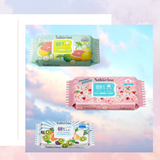3 Good Japanese Food and Skincare Products for Acne
Posted on April 21 2020

It’s a truism that “You are what you eat”, and yet not much research has been done into the relationship between acne and nutrition since one 1969 study into the subject. This, despite the fact that acne is extremely common, and causes quite a lot of emotional distress. Most of the advice I found was for foods to avoid: high-glycemic foods and foods are bad, milk is bad (a study in the journal Clinics in Dermatology disagrees), sugar is bad, bananas are bad…just, a lot of foods that I like are bad.
What foods are good, though? More importantly, will I like those foods? The answer to the first question is that the strongest evidence points to foods that are high in zinc, omega-3 fatty acids, and antioxidants, especially Vitamins A and D. The answer to the second question, at least for me, is that if it’s a Japanese food, I will probably find it tasty. If you’re here, chances are high that you also enjoy 和食 (washoku, Japanese cuisine)! Let’s dig into the data.

What causes acne?
Before we talk about which foods help with acne, we should really cover what causes acne. It’s all about sebum! Sebum is the oil that sebaceous glands in pores naturally produce to protect and moisturize the skin. When something (like makeup) clogs the pores, though, the sebum builds up. The built-up sebum encourages bacteria to reproduce in the pore, which causes inflammation, which causes the wonderful family of acne we know and love: the pimple, the cyst, the blackhead, and the whitehead. For the more scientifically-inclined sufferer, there are also papules (smaller, more sensitive red bumps) and nodules (tender lumps beneath the skin’s surface).

Why does zinc help fight acne?
Zinc is a nutritional Band-Aid—it helps heal wounds, it helps clot blood, and it may even have antiviral properties. Not only that, but according to the Journal of Drugs in Dermatology and other sources (X X X X X), zinc appears to help fight bacteria, inflammation, and sebum production, which, as we remember, are the main causes of acne.

1. Sashimi
Most dietary zinc comes from meat and seeds. Mollusks, oysters, beef, crab, and liver of all sorts are rich in zinc. Do you know what Japanese food is rich in mollusks, oysters, crab, liver, and even (yes) beef? Sashimi is! When it comes to clarity of taste in meat, there is no replacement for the simple yet elegant flavors of well-prepared sashimi. Dip the sashimi of your choice in soy sauce or other soy-based sashimi sauce and sprinkle some sesame seeds on top, and you have a taste that is both delicate and rustic. Add in the fact that soy and sesame seeds are also high in zinc, and you can enjoy your food in the knowledge that while you eat, you are also one small step closer to healing your acne.

Fatty fish like mackerel, tuna, and my favorite salmon also contain high levels of vitamin A and omega-3 fatty acids. What are those good at again? Oh right, preventing acne!

Why do Omega-3 fatty acids help fight acne?
Essential fats, or essential fatty acids, like omega-6 and omega-3 are nutrients your body needs to do basic things like take care of joints, regulate your emotions, and make sebum (a key ingredient of acne). The catch with omega-6 and omega-3 is that the ratio of omega-6 to omega-3 should be 4-1:1 for optimal health. What, you may ask, is the ratio of omega-6 to omega-3 in the average Western diet? It’s 15-16.7/1.
If there are more omega-6 acids than omega-3 acids in your body, it promotes inflammation (another key ingredient of acne). Studies have shown that an imbalance of fatty acids is linked to acne, and the skin of acne-prone individuals has less linoleic acid, which is linked to an imbalance of omega-6 and omega-3.
If a fatty acid imbalance is so bad for acne, and the Western diet is bad for the fatty acid imbalance, then maybe it’s time to look to other cuisines.

2. Tofu
If you read an earlier post on this website, you may remember that tofu is a good source of vitamin E and proteins, which protect skin cells from degradation due to age and damage, and saponin, an exfoliant. Since exfoliation decides when, if, and how much pores get clogged by dead skin cells, it’s pretty important in acne regulation. Soy isoflavone, which may help regulate female hormones, is another thing tofu is full of. Believe it or not, it also has quite a lot of omega-3 fatty acids, too!

Source: https://pixabay.com/photos/tofu-eat-food-healthy-vegetables-3562182/
Because of its subtle flavor, tofu can be paired with pretty much any other food. I remember the first time I ate agedashi dofu, a fried tofu dish, in Niigata. The perfect marriage of the green onion and tofu’s soft bitterness and the savory saltiness of the sauce changed my mind. It can be used in sweets as well! Once, I was halfway through eating what I thought was a delicious pudding dessert when I realized it was a delicious tofu dessert.

Why does vitamin A help fight acne?
Vitamin A is an antioxidant, and it also plays a role in building and maintaining skin. If you don’t have enough vitamin A, your skin gets brittle and easier to damage, which makes it easy to infect and hard to heal. The more vitamin A you have in your body, the less acidic your skin and the less sebum youproduce. Recall that more sebum means a greater chance of it building up in pores and causing inflammation, and it makes sense that these factors can help reduce acne. Add the fact that it helps regulate exfoliation, which affects if and how often your pores are blocked by dead skin, and you get a powerful acne-influencing nutrient.
To demonstrate the point, Accutane, a powerful drug that is 90% effective in dramatically reducing acne, is simply an artificial (and intensely powerful) form of a metabolite of vitamin A. If that isn’t enough, the skin of those who suffer from acne has less vitamin A than normal.

3. Yakiimo (Japanese roasted sweet potato)
What if I told you there was a food that had about 300% to 700% of your Percent Daily Value of vitamin A? That if you ate that food, you would be set for at least half a week? That legendary food is the roasted sweet potato, or yakiimo. The humble sweet potato made its way from Peru to Japan’s Miyakojima in 1594, and finally to Edo in 1734. Since then, it’s been a popular street food beginning in the fall and going strong throughout winter. The Japanese prefer to roast them on stones, but all you need to make it is some tinfoil and an oven. Bake or roast it nice and slowly, put your choice of seasoning on it, and enjoy the warm, mildly sweet, and flakey goodness of the sweet potato.

I personally don’t like the variety of potato sold in the States, so in Japan I was glad to find out they have many local types of sweet potato, including satsumaimo, yamaimo, and my favorite murasaki satsumaimo, so if you don’t like the taste of one, you can try another. Perhaps even more enjoyable than the baked potato itself are all the baked potato-flavored foods sold in Japan in the fall.
3 Effective J-Beauty Skincare Products to Fight Acne
Diet is the primary way of getting the right balance of nutrients for your body, but sometimes you want to go all-out, right? For those with true enthusiasm for acne skincare, here are three J-Beauty products that supercharge your skin with vitamins:
1. Lululun Deep Moisturizing Mask (Blue Type)
This mask is popular for good reason! Don’t let the “Deep Moisturizing” title scare you: Its citrus extracts reduce the pore-clogging dead skin on your face, and the seaweed extract contains those nice essential fatty acids we learned about. Yes, CosmeHunt does carry it!

2. LaMuse Beauty Phytocera
This is a phytoceramide and vitamins A, C, D, and E supplement rated as “the best in the market” by Consumers Survey. Phytoceramides are a form of ceramide, which protects the skin and keeps it moisturized.

Source: https://lamusebeauty.com/
3. Melano CC Spot Treatment
This is an ultra-concentrated (and affordable) vitamin C serum for those pimples that have already surfaced. Melano CC is part of Rohto-Mentholatum, the same company that runs Hada-Labo.

To find out more, visit our websites and explore our Blog more!

Lauren Goff
Lauren is a writer who spent two years teaching English in Japan and is curious about skincare products. Though she lives in America now, she is still in love with Tohoku. Her short stories and essays can be found in The Vortex Magazine of Literature and Art and Cirsova.



